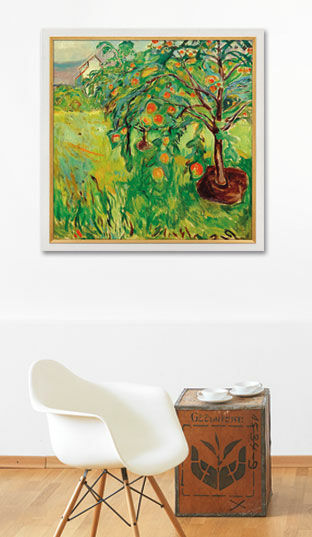Picture "Apple Tree by the Studio" (1920-28), framed


Picture "Apple Tree by the Studio" (1920-28), framed
Quick info
ars mundi Exclusive Edition | limited, 499 copies | reproduction, Giclée print on canvas | on stretcher frame | framed | size approx. 78 x 78 cm
Detailed description
Picture "Apple Tree by the Studio" (1920-28), framed
In 1916, Edvard Munch (1863-1944) bought the Ekely property, which used to be a nursery in the Oslo suburb of Skøyen. Here Munch had plenty of space to work. He lived there until the end of his life. Munch's extensive and colourful work from this phase is an expression of the favourable working conditions he enjoyed at Ekely. He created some of his most famous pictures during this period.
"Apple Tree by the Studio": Original: oil on canvas, Munch-Museet, Oslo.
Reproduction in Fine Art Giclée directly on artist's canvas and mounted on a stretcher frame. Framed in a solid wood frame. Limited edition 499 copies. Size approx. 78 x 78 cm. ars mundi Exclusive Edition.
Frame configurator
Customised picture frame

Frame configurator
Customised picture frame






Customer reviews
Frame variant: framed

About Edvard Munch
1863-1944
The Norwegian painter and graphic artist Edvard Munch was one of the most important pioneers of Expressionism. His works revolve around the great human tragedies between Eros and death and he faced the deepest human feelings relentlessly and forcefully.
The oppressive mood of his most famous work, "The Scream", was typical of Munch, whose art often dealt with the existential questions of life, primarily fear, despair, melancholy, grief, death, love and jealousy. In this sombre choice of themes, one can certainly find references to his biography: Munch lost his mother and sister at an early age and struggled with depression and alcoholism throughout his life. Like hardly any other artist, Munch was able to give expression to his state of mind and to impressively bring the emotionally strong themes onto the canvas. Although he painted representationally, he made his motifs appear peculiarly deformed and used a very dynamic painting style with powerful colours. His innovative pictorial language and his way of symbolically depicting states of mind made Edvard Munch a pioneer of Expressionism and one of the most important painters of the 19th and 20th-centuries.
In the summer of 2004, Munch's two most famous paintings, "The Scream" and "Madonna", were stolen from the Munch Museum in Oslo in the most spectacular art theft of our time. The paintings were not secured until August 2006. "The Scream" - the world's best-known work of Expressionism - was so badly damaged in the process that it could not be exhibited again until today.
Graphic or sculpture edition that was initiated by ars mundi and is available only at ars mundi or at distribution partners licensed by ars mundi.
Giclée = derived from the French verb gicler "to squirt, spurt".
The giclée method is a digital printing process. It is a high-resolution, large-format printout on an inkjet printer with special different-coloured dye- or pigment-based inks (usually six to twelve). The colours are fade-proof, i.e. resistant to harmful UV light. They have a high richness of nuance, contrast and saturation.
The giclée process is suitable for art canvases, handmade and watercolour paper as well as for silk.









